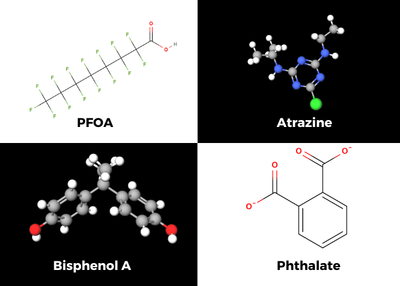Water Quality InformationWritten By Actual Experts
RSSEndocrine Disruptors In Drinking Water: What You Need To Know

Problems We Found In San José, California's Drinking Water

Chemours To Pay $13 Million to NC DEQ for PFAS Pollution

Analies Dyjak | Policy Nerd
Our Water Nerds have been closely following the environmental and public health disaster in North Carolina for a while now. This article provides an overview of the recent consent order, and some background information on what's going on in North Carolina.
The Chemours Plant in Fayetteville, North Carolina has been discharging various per and polyfluoroalkyl substances (also known as PFAS) for decades. PFAS are a category of emerging contaminants that are found in some of the most popular consumer products such as Scotchgard, Gore-Tex, Teflon, and other stain/water resistant products. PFAS is also an important ingredient in firefighting foam, which has been a major source of water contamination throughout the country. In recent years, a replacement chemical for PFOA called GenX has dominated the conversation, particularly in North Carolina. In November 2018, EPA admitted that GenX is “suggestive” of cancer, which is significant for residents who have been unknowingly exposed.
$13 Million Awarded to NCDEQ
Chemours is awarding $13 million to the North Carolina Department of Environmental Quality in the form of civil penalties and investigative costs. In comparison to other PFAS-related settlements, this is by far one of the smallest. In early 2018, 3M paid the state of Minnesota $850 Million in environmental degradation. In 2017, DuPont was involved in a $670.7 million settlement in the Mid-Ohio Valley region for PFAS water contamination.
Overview Of The Consent Order
The Consent Order clearly lays out a timeline of air emission goals and wastewater discharge stipulations. Chemours’ National Pollution Discharge Elimination System (NPDES) permit was revoked in early 2017 and the new Consent Order prohibits any sort of wastewater discharge until a NPDES permit is reallocated. Chemours must also create laboratory methods and test standards for all PFAS compounds released by the Fayetteville plant. Basic remediation plans must be agreed upon by the North Carolina Department of Environmental Quality, North Carolina River Keepers, and Chemours. Chemours will also pay for water filtration for water filtration for residents on private wells. Concentrations of GenX must be above 140 parts per trillion or any updated health advisory, in order to be eligible for a filter. GenX is not the only PFAS compound detected in the Cape Fear area, and the consent order addresses that. the Residents can also be eligible for filtration if other PFAS compounds are detected in well water over 10 parts per trillion individually, and 70 parts per trillion combined. NCDEQ is currently seeking public comment regarding the recent settlement.
How Are Cape Fear Residents Responding?
Cape Fear Public Utility Authority (CFPUA) created a comprehensive breakdown of the Chemours consent order. The utility provider acknowledged that the settlement did not go far enough to cover the scope of GenX and PFAS water contamination in the Cape Fear area. In a press release, CFPUA talked about how the consent order did not acknowledge the PFAS sediment pollution at the bottom of the Cape Fear River. Any sort of dredge or fill could disturb the sediment and create GenX concentrations to sky rocket in drinking water. Local non-profit groups are also not in agreement with the Chemours settlement because they believe it does not go far enough to mitigate the scope of PFAS water contamination. The current consent order places most of the mitigative costs water utility providers which would of course be paid for by taxpayers.
Our Take:
In early November of 2018, EPA released a draft toxicity report for GenX, proposing a threshold of 80 parts per trillion for drinking water. The concentration deemed “safe” by North Carolina and Chemours is almost two times higher than what the EPA is proposing as safe. Health and regulatory agencies know very little about the adverse health effects of GenX and other PFAS compounds. It’s up to consumers to decide the best course of action to protect themselves and their families.
Other Articles We Think You Might Enjoy:EPA Admits That GenX Is Linked To Cancer
Military Bases and PFAS
Toxicological Profile For PFAS
Problems We Found In San Diego, California's Drinking Water

Breaking: 3M Pays Minnesota $850M For Decades Of Water Contamination
Analies Dyjak | Policy Analyst
This past Tuesday, February 20th, 2018, a lengthy lawsuit of eight-years ended in an $850 million settlement in favor of the state of Minnesota.
If you’re unfamiliar with the water crisis in Minnesota, here’s a quick recap:
In 2010 the state of Minnesota filed suit against 3M, a manufacturing company based out of Maplewood, Minnesota. The lawsuit came about because of allegations that 3M had been knowingly and improperly disposing of perfluorinated chemicals (PFC’s) such as perflurooctanoic acid (PFOA), and perfluorooctanesulfonic acid (PFOS) for decades. This probably sounds familiar to GenX contamination in North Carolina. 3M publicly stated their phase-out of PFC-like compounds in 2000. In 2004, 67,000 households in communities such as Lake Elmo, Oakdale, Woodbury and Cottage Grove had traces of PFC’s in their drinking water. In 2010, the state of Minnesota initially asked for $5 billion from 3M for natural resource and environmental degradation. In a last ditch effort to avoid trial, the state of Minnesota was granted an $850 million settlement on behalf of 3M. 3M claims that the settlement doesn’t make them guilty of poisoning thousands of people in Minnesota, but rather to show their commitment to environmental stewardship.
How Did The PFC Contamination Get Into Drinking Water?
3M had been disposing of PFC’s in their privately owned landfills as well as certain public landfills in Washington County since the 1950’s. It’s uncertain if 3M disclosed to the public landfills that PFOA’s and PFOS’s would be a part of their industrial hazardous waste permits. Additionally, cap technology in the in the 1950’s and up to the 1970’s was not nearly as advanced as it is today. Once the chemicals were disposed of in the landfill, over time they leached through the lining and into surrounding groundwater.
Health Effects of PFC’s, PFOA’s and PFOS’s
Health experts in Minnesota have seen higher rates of cancers, leukemia, premature births and lower fertility rates in suburbs near 3M manufacturing. This is a pretty constant trend when looking into long term exposure of perfluorinated chemicals. A University of California, Berkeley professor reported a 30% increase in low birth-weights and premature births between the years of 2001 and 2006 in Oakdale, a suburb of a 3M manufacturing plant.
Where Will the Money GO?
According to the Minnesota Attorney General, the settlement will be used to fund projects involving drinking water and water sustainability (whatever that means). $850 million may seem like a substantial peace offering, but the state came to the conclusive amount of $5 billion for a reason. This was the well-researched amount of money that state experts determined for damage done by 3M. Does this mean that the drinking water problem is completely fixed? No. It’s not guaranteed that every household will receive compensation and funding for a proper filtration system. The same UC Berkeley professor estimated the economic cost of the pollution; $1.5 billion in natural resource damages, $830 million in financial damages to existing households, and $309 million for people moving to the area by 2050. So although the settlement is significant, it won’t nearly be able to remediate all existing damages.
Summary
The settlement in Minnesota is a win for the environmental and the millions of individuals affected by 3M. There is still uncertainty regarding how the settlement money will be allocated, and which projects will be prioritized.
_______________________________________________________________
Brief History of 3M in Minnesota
3M initially began producing PFC’s in the 1950’s. Of course commercial-scale production of PFC’s were almost completely unregulated during this time. The Clean Water Act and National Environmental Policy Act weren’t codified until 1970. Knowledge of PFC-like contaminants was minimal and economic pressure was high.
Prior to any knowledge of PFC’s, 3M focused its attention on remediation efforts to volatile organic compounds (VOC’s). VOC’s were first found in groundwater in Washington County in 1966. Because of this, state permitting agencies and 3M were all aware of the hydrology of this area.
Other Articles We Think You'll Enjoy
How Another Chemical Plant Contaminated An Entire Watershed With PFCsWhat You Need To Know About Groundwater
Things Most People Don't Know About Well Water Contamination





